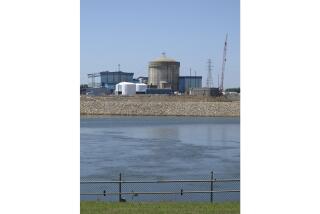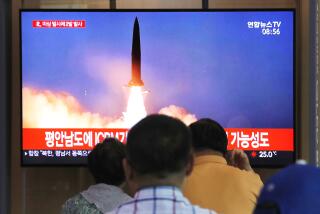Threat Is Seen at Nuclear Reactors
- Share via
Spent nuclear fuel stored at commercial reactors across the nation may be vulnerable to terrorist attacks that would set off fires and disperse radiation to surrounding areas, nuclear experts warned Wednesday.
A report by the National Academy of Sciences recommended that all the nation’s 103 commercial reactors be examined by the Nuclear Regulatory Commission and that measures be taken to reduce the potential for fires if the plants were attacked.
Louis J. Lanzerotti, chairman of the academy panel that conducted the study and a consultant to Bell Laboratories in New Jersey, said the committee considered air- and ground-attack scenarios, but details and assumptions about terrorist capabilities were contained in a classified version of the report delivered to Congress.
The academy’s conclusions have been disputed by the Nuclear Regulatory Commission and the nuclear power industry.
The study was requested by Congress to examine the vulnerability of tens of thousands of tons of spent radioactive fuel across the nation. Every nuclear power plant must store spent fuel rods for at least five years after they are removed from re- actors, allowing them to radio- actively decay and cool down.
After about five years, the rods can be removed from the pools and stored in dry casks, which are generally less vulnerable to an attack intended to disperse radiation, the panel said.
The report concludes that a successful attack could breach a spent fuel pool, allowing cooling water to drain out. The high heat generated by the uncooled nuclear fuel could ignite the zirconium cladding on the fuel rods, ultimately melting the uranium pellets inside and spreading radioactive materials, said Kevin Crowley, a nuclear expert at the academy, who led the study.
To protect against that risk, the report suggests that utilities take two key steps: Reposition fuel rods so they would generate less heat if cooling water is lost, and install sprinklers that would continue to cool the fuel if the pool is breached.
In a letter to Congress, the regulatory commission said that some of the panel’s recommendations were unnecessary and that the panel’s assessment lacked an adequate technical base. In addition, the nuclear industry argues that any risk of an attack that would spread contamination is extremely remote.
“I am more worried about getting hit by a meteor walking out of my front door in the morning,” said Craig Nesbit, a spokesman for Exelon, the nation’s largest operator of nuclear power plants.
Nesbit said the pool buildings that house the spent fuel would make small, difficult-to-hit targets for aircraft flown by a suicidal terrorist. In addition, the walls of the pools are made of concrete 5 feet thick and clad in stainless steel -- what he called a significant defense against any kind of attack. The spent fuel has 40 feet of water on top of it.
The academy was not asked to assess the vulnerabilities of reactor containment buildings or any other parts of nuclear power plants.
The academy report implicitly acknowledges that not every storage pool is equally at risk. In some cases, the pools are below ground or are protected from “external line of sight attacks by exterior walls and other structures,” the report said. But other pools are above ground level, near the reactor building.
The Department of Energy is evaluating the ability of its nuclear weapons laboratories to defend against a ground-based terrorist attack. Energy officials have grown increasingly concerned that a team of terrorists using high explosives could penetrate steel fences and thick concrete walls in seconds to access nuclear materials.
The nation’s nuclear power plants apparently face the same risks. “While it would be difficult to attack such facilities,” the academy report said, “the committee judges that attacks by knowledgeable terrorists with access to appropriate technical means are possible.”
More to Read
Sign up for Essential California
The most important California stories and recommendations in your inbox every morning.
You may occasionally receive promotional content from the Los Angeles Times.














